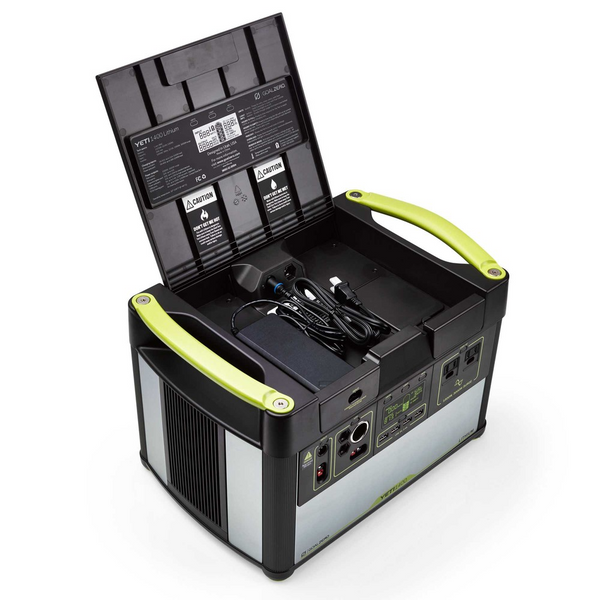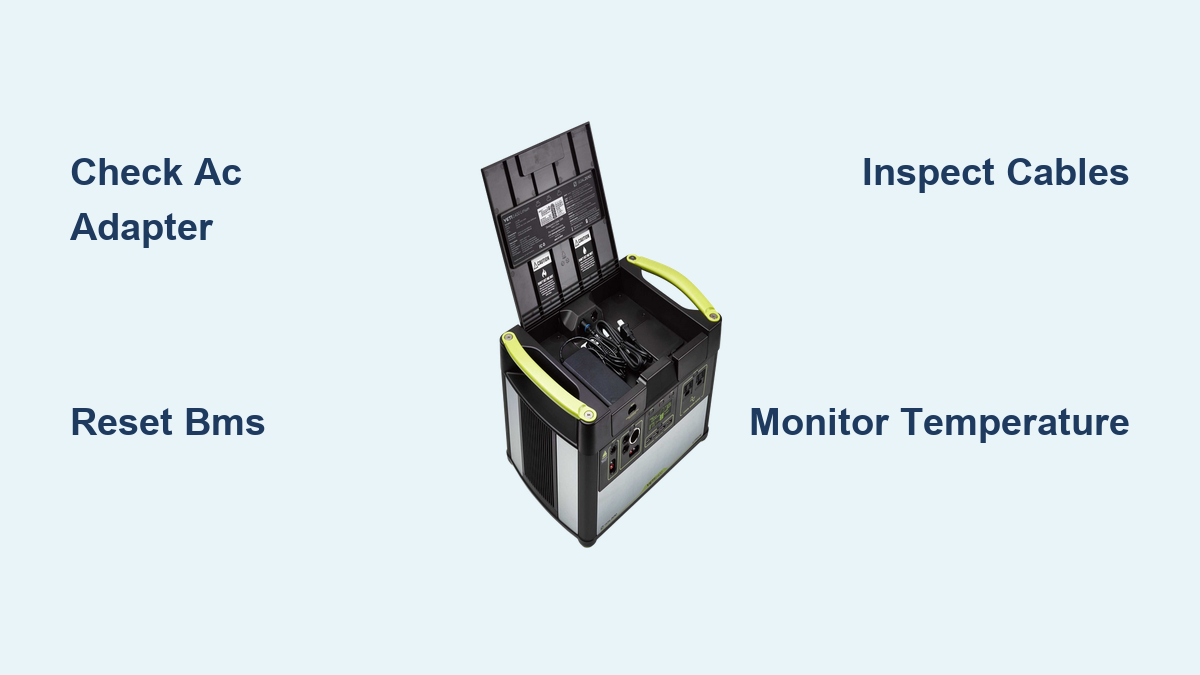Are you frustrated that your Goal Zero Yeti 1400 isn’t charging? It’s incredibly disheartening when your reliable power station lets you down, especially when you need it most. Often, a simple reset or cable check is all it takes to get it back up and running. This quick fix can get you powered up immediately.
This comprehensive guide goes beyond a simple reset, diving deep into the potential causes of your Yeti 1400’s charging issues and offering multiple solutions. We’ll cover everything from basic troubleshooting steps to more advanced diagnostics, ensuring you have the knowledge to confidently resolve the problem and keep your Yeti 1400 ready for any adventure. By the end of this article, you’ll be equipped to diagnose and fix the issue, or determine when professional help is needed.
Common Causes of Goal Zero Yeti 1400 Not Charging
Several factors can prevent your Goal Zero Yeti 1400 from charging. Here’s a breakdown of the most common culprits:
Faulty AC Adapter
The AC adapter is the most frequent point of failure. Damage to the adapter itself or its cable can interrupt the power flow. Look for frayed wires, bent pins, or a loose connection.
Damaged Charging Cables
Whether using the AC adapter cable or a solar charging cable, damage can prevent efficient power transfer. Inspect cables for cuts, kinks, or loose connections.
Incompatible Charger
Using a charger with insufficient wattage or incorrect voltage can prevent the Yeti from charging properly. Always use the Goal Zero-provided AC adapter or a compatible high-wattage charger.
Battery Management System (BMS) Issues
The Yeti 1400’s BMS protects the battery from damage. Sometimes, a glitch in the BMS can temporarily prevent charging. This is often resolved with a reset.
Overheating
If the Yeti 1400 has been exposed to extreme temperatures or is operating in a poorly ventilated area, it may shut down charging to protect the battery.
Low Temperature
Like overheating, extremely cold temperatures can also prevent the battery from accepting a charge.
How to Fix Goal Zero Yeti 1400 Not Charging

Here are several methods to troubleshoot and fix your Goal Zero Yeti 1400’s charging problem, ranging from simple checks to more involved solutions:
Method 1: Basic Checks & Reset (Quick Fix)
This is the first step and often resolves the issue.
Diagnosing the Issue
Confirm the Yeti isn’t simply depleted. Try turning it on. If it doesn’t power on, proceed with the reset.
Fix Steps
- Power Cycle: Turn off the Yeti 1400 completely. Disconnect the AC adapter.
- Reset the BMS: Press and hold the power button for 30 seconds. This forces a reset of the Battery Management System.
- Reconnect & Test: Plug the AC adapter back in and attempt to charge the Yeti.
Testing
Monitor the charging indicator lights. If the green lights begin to illuminate, the reset was successful.
Method 2: Inspect and Replace Cables & Adapter
A faulty cable or adapter is a common cause.
Diagnosing the Issue
Visually inspect the AC adapter and charging cables for any signs of damage.
Fix Steps
- Cable Check: Try a different, known-good AC charging cable.
- Adapter Check: If possible, test with a different Goal Zero AC adapter (ensure it’s compatible with the Yeti 1400).
- Outlet Test: Plug the AC adapter into a different wall outlet to rule out a faulty outlet.
Testing
If the Yeti charges with a different cable or adapter, the original is likely faulty and needs replacement.
Method 3: Temperature Considerations & Ventilation
Overheating or cold temperatures can inhibit charging.
Diagnosing the Issue
Check the ambient temperature. Is the Yeti in direct sunlight, a hot vehicle, or a freezing environment?
Fix Steps
- Relocate: Move the Yeti to a cool, shaded location with good ventilation. Ideal charging temperature is between 32°F and 104°F (0°C and 40°C).
- Allow to Stabilize: Let the Yeti reach a moderate temperature before attempting to charge it again.
Testing
Monitor the charging indicator after moving the Yeti to a suitable environment.
Method 4: Advanced BMS Reset & Firmware Update
If the basic reset doesn’t work, a more in-depth BMS reset or firmware update might be necessary.
Diagnosing the Issue
If the Yeti still won’t charge and the temperature is within range, the BMS might require a more thorough reset.
Fix Steps
- Long BMS Reset: Disconnect all devices from the Yeti. Press and hold the power button for a full 60 seconds.
- Firmware Update: Connect the Yeti to a power source and your computer. Download the latest firmware from the Goal Zero website and follow the instructions for updating the Yeti’s firmware.
Testing
After the extended BMS reset or firmware update, attempt to charge the Yeti.
How to Prevent Future Charging Issues

Preventative maintenance can significantly reduce the risk of charging problems.
Regular Cleaning
Keep the charging ports and vents free of dust and debris. Use a soft, dry cloth to clean them regularly.
Proper Storage
Store the Yeti 1400 in a cool, dry place, away from direct sunlight and extreme temperatures.
Battery Maintenance
Avoid fully discharging the Yeti 1400 regularly. It’s best to keep the battery between 20% and 80% charge for optimal lifespan.
Cable Management
Handle charging cables with care. Avoid kinking, bending, or stepping on them.
Pro Tips for Goal Zero Yeti 1400 Owners
- Use a Surge Protector: Protect your Yeti from power surges by plugging it into a high-quality surge protector.
- Monitor Battery Health: Regularly check the battery health indicator on the Yeti’s display.
- Avoid Simultaneous Charging & Discharging: Avoid using the Yeti while it’s charging, as this can put stress on the battery.
- Solar Charging Optimization: When using solar panels, ensure they are positioned for maximum sunlight exposure.
- Firmware Updates are Crucial: Regularly check for and install firmware updates from Goal Zero.
Professional Help
When to Seek Professional Assistance
- If none of the above solutions work.
- If you suspect internal damage to the Yeti 1400.
- If the Yeti is still under warranty.
Finding a Qualified Technician
Contact Goal Zero support for authorized service centers in your area.
Typical Cost Ranges
Repair costs can vary depending on the issue. Expect to pay anywhere from $100 to $400 for common repairs.
FAQ
Q: How long should it take to charge my Yeti 1400?
A: With the included AC adapter, it typically takes around 8-10 hours to fully charge the Yeti 1400 from empty. Solar charging times vary depending on panel wattage and sunlight conditions.
Q: Can I use a different AC adapter than the one provided?
A: Only use Goal Zero-approved adapters or those with the correct voltage (18V) and wattage (at least 200W) to avoid damaging the Yeti.
Q: What do the LED indicator lights mean?
A: The LED lights indicate the charging status. Solid green means fully charged, flashing green means charging, and solid red indicates an error or low battery.
Q: My Yeti gets hot during charging. Is this normal?
A: Some warmth is normal, but excessive heat is not. If the Yeti becomes extremely hot, disconnect it and move it to a cooler location.
Q: What if my Yeti won’t turn on at all?
A: Try holding the power button for 60 seconds to perform a hard reset. If it still doesn’t turn on, contact Goal Zero support.
Get Your Yeti 1400 Working Again
Following this guide, you now have multiple solutions to fix your charging issues:
- Basic troubleshooting steps like resets and cable checks
- Temperature considerations
- Advanced BMS resets and firmware updates
Don’t let a charging issue sideline your Yeti 1400. Try these methods in order, and you’ll have your power station back to full capacity in no time.
Have you successfully fixed your Goal Zero Yeti 1400? Share your experience in the comments below to help other readers!

